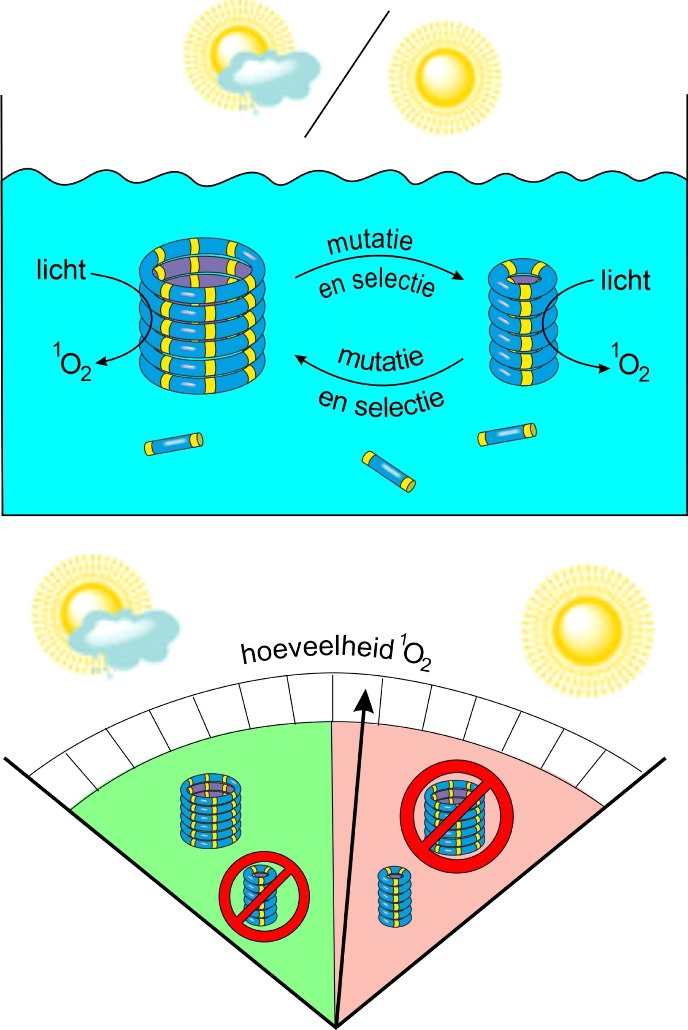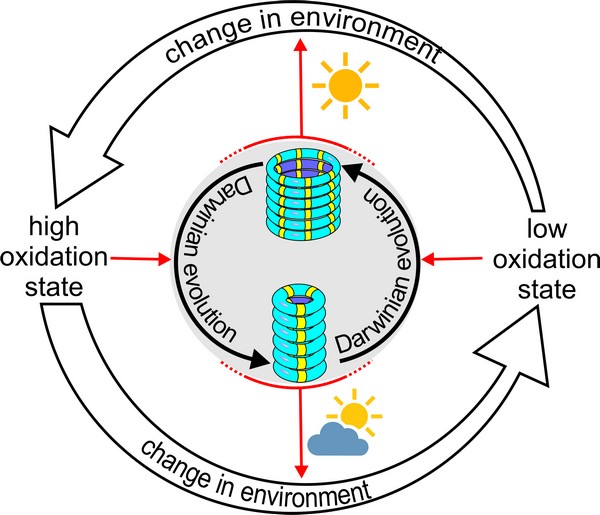Evoluerend chemisch systeem verandert de eigen omgeving
Een chemisch systeem dat bestaat uit synthetische replicatoren vertoont de eerste tekenen van Darwiniaanse evolutie: er is competitie tussen twee verschillende replicatoren die dezelfde bouwsteen nodig hebben, en welke van beide wint hang af van de omgeving. Omdat de replicatoren hun omgeving ook veranderen ontstaat er een ecologisch-evolutionaire dynamiek. Deze bevinding laat zien dat Darwiniaanse principes ook buiten de biologie kunnen bestaan. Deze resultaten, die mogelijk zijn te gebruiken om nieuwe katalysatoren te ontwikkelen, zijn door RUG-chemici gepubliceerd in het tijdschrift Nature Chemistry op 31 augustus.
FSE Science Newsroom | René Fransen
Wat is leven? Die vraag houdt wetenschappers al eeuwen bezig. Sijbren Otto, hoogleraar systeemchemie aan de RUG, zoekt het antwoord door te proberen een simpele vorm van leven te maken. Hij heeft uitgebreid geëxperimenteerd met monomeren, bouwstenen die ringetjes vormen door met elkaar te reageren. De ringetjes stapelen zich vervolgens op tot vezels. In dit proces zorgen de ringetjes voor meer ringetjes waardoor de vezels groeien en zich delen. Eerder onderzoek van Otto heeft laten zien dat de vezels ook als lichtgevoelige katalysator kunnen werken, en zo de vorming van de moleculen waaruit ze zijn opgebouwd versnellen: een primitieve vorm van stofwisseling.

Muteren
In hun nieuwste onderzoek hebben Otto en zijn team zich gericht op een ander belangrijk aspect van leven: Darwiniaanse evolutie. Zij bestudeerden vezels die zijn opgebouwd uit zichzelf kopiërende ringen van twee verschillende groottes: 3-ringen en 6-ringen (gemaakt uit drie of zes monomeren). Alle ringetjes bestaan uit dezelfde monomeren, waar ze dus om met elkaar om concurreren’, legt Otto uit. ‘We plaatsten dit systeem in een flow-cel waar we een oplossing van monomeren met een constante snelheid aan toevoegden. Tegelijkertijd haalden we een zelfde hoeveelheid vloeistof uit de cel.’ De onderzoekers zagen hoe de vezels zich voortplantten en evolueerden, door hun ringgrootte te veranderen.
In dit systeem overleven de replicatoren alleen wanneer de snelheid waarmee ze zich voortplanten groter is dan de snelheid waarmee ze uit de flow-cel worden afgevoerd. De twee verschillende replicatoren groeiden met verschillende snelheid bij verschillende condities: de 3-ringen groeiden het snelst in een omgeving die sterk was geoxideerd, terwijl de 6-ring ging overheersen in een minder geoxideerde omgeving. Otto: ‘We zagen dat de replicatoren konden muteren naar een andere ringgrootte als het niveau van oxidatie in de cel veranderde. Dus bleken de replicatoren in staat om zich aan te passen aan een veranderende omgeving.’

Dynamiek
Dit systeem is vervolgens verder ontwikkeld door de replicatoren het vermogen te geven om hun omgeving aan te passen als reactie op de aanwezigheid van licht. Bij zwak licht was er weinig oxidatie, zodat de 6-ringen konden domineren. Maar bij sterk licht veroorzaakten de 6-ringen een sterkere oxidatie, waardoor ze hun eigen omgeving vergiftigden. Onder deze omstandigheden groeiden zij minder snel en namen de mutanten die bestonden uit 3-ringen het over.
‘Ons systeem is heel simpel, maar vertoont een deel van de dynamiek die je alleen ziet in levende systemen’, zegt Otto. ‘We hebben laten zien dat een soort natuurlijke selectie bepaalt welke replicator de overhand krijgt, maar ook dat deze replicatoren hun omgeving kunnen veranderen. En dat heeft weer invloed op de evolutie van de replictoren. Dit soort eco-evolutionaire dynamiek is heel gewoon in de biologie en het is nu duidelijk dat dit ook zo is in ons synthetische systeem.’ Toch noemt Otto zijn systeem nog niet ‘levend’, want dan zou het nog meer kenmerken moeten vertonen, zoals compartimentalisatie van de replicatoren in een soort cel-achtige structuren.
(lees door onder de foto)

Nieuwe materialen
‘Maar het is zeker interessant dat Darwiniaanse principes, die de hoeksteen zijn van de biologie, ook zijn te introduceren in ons synthetische systeem. We hadden al replicatie en stofwisseling, en nu ook nog een beperkte mate van Darwiniaanse evolutie’, concludeert Otto. ‘Het is allemaal nog erg rudimentair, maar we zijn benieuwd hoe ver we ons systeem kunnen ontwikkelen om nog meer tekenen van leven te vertonen.’ Zijn experimenten zijn niet alleen interessant om te laten zien hoe chemische systemen tot leven kunnen komen, maar een vergelijkbaar systeem zou ook de inventieve krachten van Darwiniaanse evolutie kunnen gebruiken om bijvoorbeeld nieuwe katalysatoren of materialen te ontwikkelen.
Referentie: Kai Liu, Alex Blokhuis, Chris van Ewijk, Armin Kiani, Juntian Wu, Wouter H. Roos en Sijbren Otto: Light-driven eco-evolutionary dynamics in a synthetic replicator system. Nature Chemistry, 31 augustus 2023
Meer over het onderzoek uit de groep van Sijbren Otto:
08 maart 2023: 2023 Izatt-Christensen Award toegekend aan Prof. Sijbren Otto
26 juni 2020: Basale stofwisseling in ‘levende’ moleculen
09 April 2017: Evolving molecules point to principles of life
04 januari 2016: De oorsprong van chemische soorten
27 March 2013: Leven maken in het lab
Meer nieuws
-
19 december 2025
Mariano Méndez ontvangt Argentijnse RAÍCES-prijs
-
18 december 2025
Waarom innoveren, en voor wie?
-
17 december 2025
Ben Feringa wint Feynmanprijs
